
Discover Non-Toxic Yoga Mats for a Healthier Practice
In the world of yoga, the choice of yoga mat is crucial not only for the practice but also for overall health. Non-toxic yoga mats provide a healthier and more sustainable option for practitioners, offering benefits that extend beyond the mat. Understanding what makes a yoga mat non-toxic, choosing the right non-toxic yoga mat, and maintaining it properly are essential for a balanced and eco-friendly yoga practice. Let's explore the key takeaways from this insightful journey into non-toxic yoga mats.
Key Takeaways
- Non-toxic yoga mats promote a healthier and more sustainable yoga practice.
- Look for materials like natural rubber, TPE, and cork when choosing a non-toxic yoga mat.
- Consider eco-friendly options such as biodegradable and recyclable materials for a more sustainable practice.
- Allergy considerations are important when selecting a non-toxic yoga mat, so be mindful of potential allergens in the materials.
- Regular cleaning and proper storage are essential for maintaining the integrity and longevity of non-toxic yoga mats.
Understanding Non-Toxic Yoga Mats
What Makes a Yoga Mat Non-Toxic?
When choosing a non-toxic yoga mat, it's crucial to prioritize safety and environmental impact. Look for mats made from natural, biodegradable materials such as organic cotton, natural rubber, or jute. These materials are free from harmful chemicals and provide a sustainable option for your practice.
Consider the following factors when evaluating non-toxic yoga mats:
- Material Composition: Check for certifications such as OEKO-TEX or GOTS to ensure the mat is free from toxic substances.
- Eco-Friendly Options: Look for mats that are recyclable, biodegradable, or made from renewable resources.
- Considerations for Allergies: If you have sensitivities, opt for mats that are hypoallergenic and free from latex, PVC, and other common allergens.
Tip: To maintain the non-toxic properties of your yoga mat, clean it regularly with a natural, non-toxic cleaner and store it in a cool, dry place away from direct sunlight and moisture.
Benefits of Using Non-Toxic Yoga Mats
When it comes to practicing yoga, health and wellness are top priorities. Non-toxic yoga mats offer a safer and more sustainable option for yogis. These mats are designed to minimize exposure to harmful chemicals and provide a healthier environment for your practice. In fact, a study found that non-toxic mats have a significantly lower impact on the environment compared to traditional mats. Here's a quick comparison:
| Aspect | Non-Toxic Mats | Traditional Mats |
|---|---|---|
| Material | Natural rubber and jute | PVC and other synthetic materials |
| Biodegradability | Yes | No |
| Toxic chemicals | None | Present |
It's clear that non-toxic mats align with the principles of yoga, promoting harmony with the environment and personal well-being. When choosing a yoga mat, consider the long-term benefits of a non-toxic option for your health and the planet.
Choosing the Right Non-Toxic Yoga Mat
Materials to Look for
When selecting a non-toxic yoga mat, the material composition is crucial for ensuring your practice is safe and healthy. Look for mats made from natural materials such as organic cotton, natural rubber, or jute. These materials are not only better for the environment but also tend to be free from harmful chemicals like PVC, phthalates, and heavy metals.
- Natural Rubber: Derived from rubber trees, this material provides excellent grip and cushioning.
- Organic Cotton: Soft and sustainable, organic cotton mats support practices that require a softer surface.
- Jute: A highly durable and breathable material that offers a unique texture and natural feel.
Tip: Always check for certifications such as OEKO-TEX or GOTS to ensure the materials meet stringent non-toxic standards.
Avoiding synthetic materials is not just about personal health; it's also a step towards a more sustainable practice. By choosing eco-friendly materials, you contribute to reducing the environmental footprint of your yoga practice.
Eco-Friendly Options
When considering eco-friendly options for non-toxic yoga mats, it's essential to look for materials that are both sustainable and kind to the environment. Many eco-conscious yogis opt for mats made from natural rubber, organic cotton, or jute, as these materials are biodegradable and renewable.
- Natural Rubber: Harvested sustainably, it provides excellent grip and cushioning.
- Organic Cotton: Soft, absorbent, and durable, ideal for restorative practices.
- Jute: A natural fiber that combines breathability with a unique texture for slip resistance.
Tip: Always check for certifications like OEKO-TEX or GOTS to ensure the materials meet strict environmental and health standards.
Choosing an eco-friendly yoga mat not only supports your health but also contributes to a healthier planet. These mats often come with the added benefit of being recyclable or compostable at the end of their life cycle, reducing waste and promoting a circular economy.
Considerations for Allergies
When choosing a non-toxic yoga mat, it's important to consider any allergies you may have. Some materials used in yoga mats, such as latex, can trigger allergic reactions in sensitive individuals. It's crucial to carefully review the mat's materials and ensure they are safe for your specific allergies.
Additionally, if you have allergies, you may want to consider using a natural rubber yoga mat, as it is often hypoallergenic and free from harmful chemicals. Here's a simple table to compare different materials and their allergy considerations:
| Material | Allergy Considerations |
|---|---|
| PVC | High risk of allergies |
| TPE | Low risk of allergies |
| Natural Rubber | Hypoallergenic |
Remember to prioritize your health and well-being when selecting a yoga mat. If you have allergies, consult with a healthcare professional to determine the best non-toxic yoga mat for your practice.
Maintaining Non-Toxic Yoga Mats
Cleaning and Care Tips
When it comes to cleaning and caring for your non-toxic yoga mat, it's important to use gentle cleaning solutions and avoid harsh chemicals. A simple solution of mild soap and water is effective for regular cleaning. For deeper cleaning, consider using a vinegar and water solution to remove stubborn stains. Additionally, it's essential to air dry the mat thoroughly after cleaning to prevent moisture buildup and potential mold growth. To maintain the integrity of your mat, avoid using excessive heat or direct sunlight for drying.
Storage Recommendations
When it comes to maintaining your non-toxic yoga mat, it's important to follow proper cleaning and care tips. Regular cleaning with a gentle, non-toxic cleaner can help preserve the integrity of the mat and ensure a hygienic practice environment. Additionally, proper storage recommendations are essential for prolonging the lifespan of your yoga mat. Consider storing it in a cool, dry place away from direct sunlight and moisture to prevent deterioration and maintain its non-toxic properties.
Cleaning and Care Tips
- Use a gentle, non-toxic cleaner
- Avoid harsh chemicals and abrasives
- Air dry completely before rolling up
Storage Recommendations
- Store in a cool, dry place
- Keep away from direct sunlight and moisture
- Avoid folding or creasing the mat
Tip: Regularly cleaning and proper storage can help extend the life of your non-toxic yoga mat, ensuring a healthier and more sustainable yoga practice.
Maintaining non-toxic yoga mats is essential for a healthy and eco-friendly yoga practice. At Yune Yoga, we are committed to providing the best yoga accessories for health and fitness enthusiasts. Our non-slip and eco-friendly yoga mats are beautifully designed and uniquely crafted to enhance your yoga experience. In addition to yoga mats, we offer yoga towels and straps that are perfect for leveling up your yoga and exercise routine. Visit Yune Yoga today to explore our wide range of yoga accessories and take your yoga practice to the next level!
Conclusion
In conclusion, choosing a non-toxic yoga mat is essential for a healthier practice. By prioritizing sustainability and safety, practitioners can enjoy their yoga sessions with peace of mind, knowing that they are supporting their health and the environment.
Frequently Asked Questions
Are non-toxic yoga mats safe for children to use?
Yes, non-toxic yoga mats are safe for children as they are free from harmful chemicals and materials that could be harmful to their health.
Can non-toxic yoga mats provide the same level of grip as traditional mats?
Yes, many non-toxic yoga mats are designed to provide excellent grip and traction, ensuring a safe and stable practice.
How often should I clean my non-toxic yoga mat?
It is recommended to clean your non-toxic yoga mat after every practice to maintain hygiene and extend its lifespan.
Are there non-toxic yoga mats suitable for people with latex allergies?
Yes, there are non-toxic yoga mats made from latex-free materials to accommodate individuals with latex allergies.
Do non-toxic yoga mats have a strong chemical odor?
No, non-toxic yoga mats are free from strong chemical odors commonly found in traditional mats, making them more pleasant to use.
Can non-toxic yoga mats be recycled at the end of their lifespan?
Yes, many non-toxic yoga mats are made from recyclable materials, offering an eco-friendly option for disposal at the end of their lifespan.


